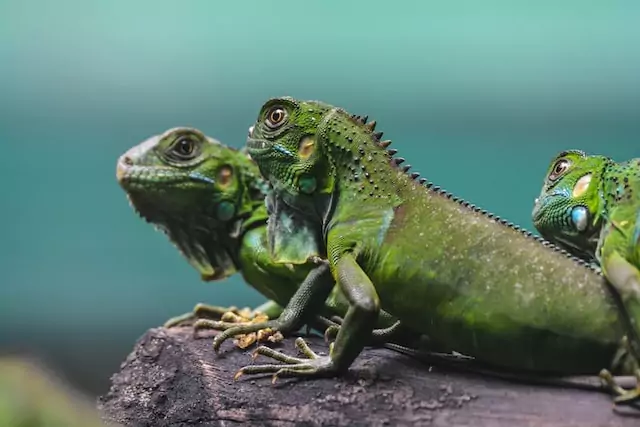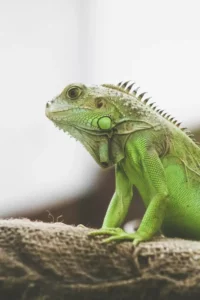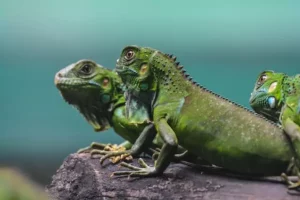0

The Americas are home to the huge, attractive green iguana. Despite its moniker, green iguanas can be in a variety of hues. They may be green, purple, crimson, orange, black, or even reddish brown in hue. They may also have bright blue patterns and be bluish in color.
Green iguanas protect themselves from predators by a row of spines that runs along their backs and along their tails.
Their whip-like tails deliver piercing blows. And like many other lizards, an iguana can let its tail break if it is captured. This allows it to flee and eventually grow a new tail. Iguanas also have a well-developed dewlap that aids in controlling their body temperature.

The green iguana is an arboreal, nocturnal reptile. They are excellent climbers and can survive falls of up to 50 feet (15 m) without injury (iguanas use their hind leg claws to clasp leaves and branches to break a fall). Green iguanas like to stay on the ground during cold, wet weather since it is warmer there.
These lone lizards are good swimmers and typically reside near bodies of water. Iguanas swim with their four legs dangling loosely against their sides while they remain submerged. They use strong tail strokes to move through the water. Iguanas typically freeze or hide when threatened.
Green iguanas are herbivorous reptiles by nature. They consume the growing shoots and leaves of more than 100 different plant species, as well as mustard and dandelion greens, flowers, and fruit. a lone adult Green iguanas can consume grasshoppers, tree snails, and bird eggs.
Polygynandrous (promiscuous) mating is the norm for green iguanas. This indicates that both sexes mate with various partners. The dry season is when breeding takes place. Males typically exhibit more dominant actions during this period, such as head bobbing and tail whipping.
Additionally, they typically grow a higher dorsal crest and dorsal spines compared to females (or spikes). Females have a synchronized nesting cycle where they lay clutches of 20 to 71 eggs once a year. After egg-laying, they do not provide parental protection beyond defending the nesting burrow while it is being excavated. After 10 to 15 weeks of incubation, the hatchlings leave the nest.
Once hatched, the baby iguanas resemble adult females more than males and lack dorsal spines, but they are otherwise comparable to adults in terms of color and structure. For the first year of their lives, children remain with their families.
Green iguanas are the only species of reptiles that do this, as males in these groups frequently utilize their own bodies to shelter and protect females from predators. Green iguanas typically reach reproductive maturity between the ages of 2-4.
Throughout its native habitat, green iguana meat and eggs have traditionally been a source of protein. People love them for their reputed therapeutic and aphrodisiac qualities.
These lizards’ hides are also used to make leather. The international pet trade, the destruction of their natural habitat owing to development, and the conversion of land for grazing are all serious problems for green iguanas.
The Green Iguana is widespread and locally abundant across its habitat, although there is no estimate of its total population, according to IUCN. On the IUCN Red List, this species is now categorized as Least Concern (LC).
These stunning lizards are vital to the habitat in which they dwell. Green iguanas are particularly useful as seed dispersers because of their food. Additionally, they are a prey species for both local predators and people.
Because reptiles are more sensitive to environmental changes than people are, green iguanas can potentially be a sign of a changing environment. Therefore, if people pay attention to their reactions, we can prevent potential issues before they get out of hand.
Due to their placid nature and vibrant hues, green iguanas are frequently kept in captivity as pets. These lizards are in high demand in the American pet trade. In 1995 alone, 800,000 iguanas came to the United States. Mostly from captive agricultural enterprises located in their home nations (Honduras, El Salvador, Colombia, and Panama).
However, these animals require a lot of maintenance over their lifetime, and many pass away shortly after you buy them.
Semi-domesticated is the status of a household.

The Taino word for the species, iwana, is the source of the Spanish word “iguana.”
The Green Iguana is also known as “gallina de palo,” which translates to “bamboo chicken” or “chicken of the trees” in South and Central America.
Due to their superb vision, green iguanas can recognize forms and motions at a great distance. These lizards have “double cone cells,” which are cells that allow them to see ultraviolet rays and have excellent color vision.
When Green Iguanas sunbathe, they can make sure they are absorbing enough sunshine in the form of UVA and UVB to create vitamin D because of this capacity.
Although this “eye” is unable to create images, it can sense movement and is sensitive to changes in light and dark. This aids the iguana in seeing predators circling above.
With their razor-sharp teeth, green iguanas can rip through human flesh and even shredded leaves. These teeth have a leaf-like form, are flat and broad, and have serrations around the edge.
The teeth are difficult to see in smaller specimens because they are on the inside sides of the jawbones.